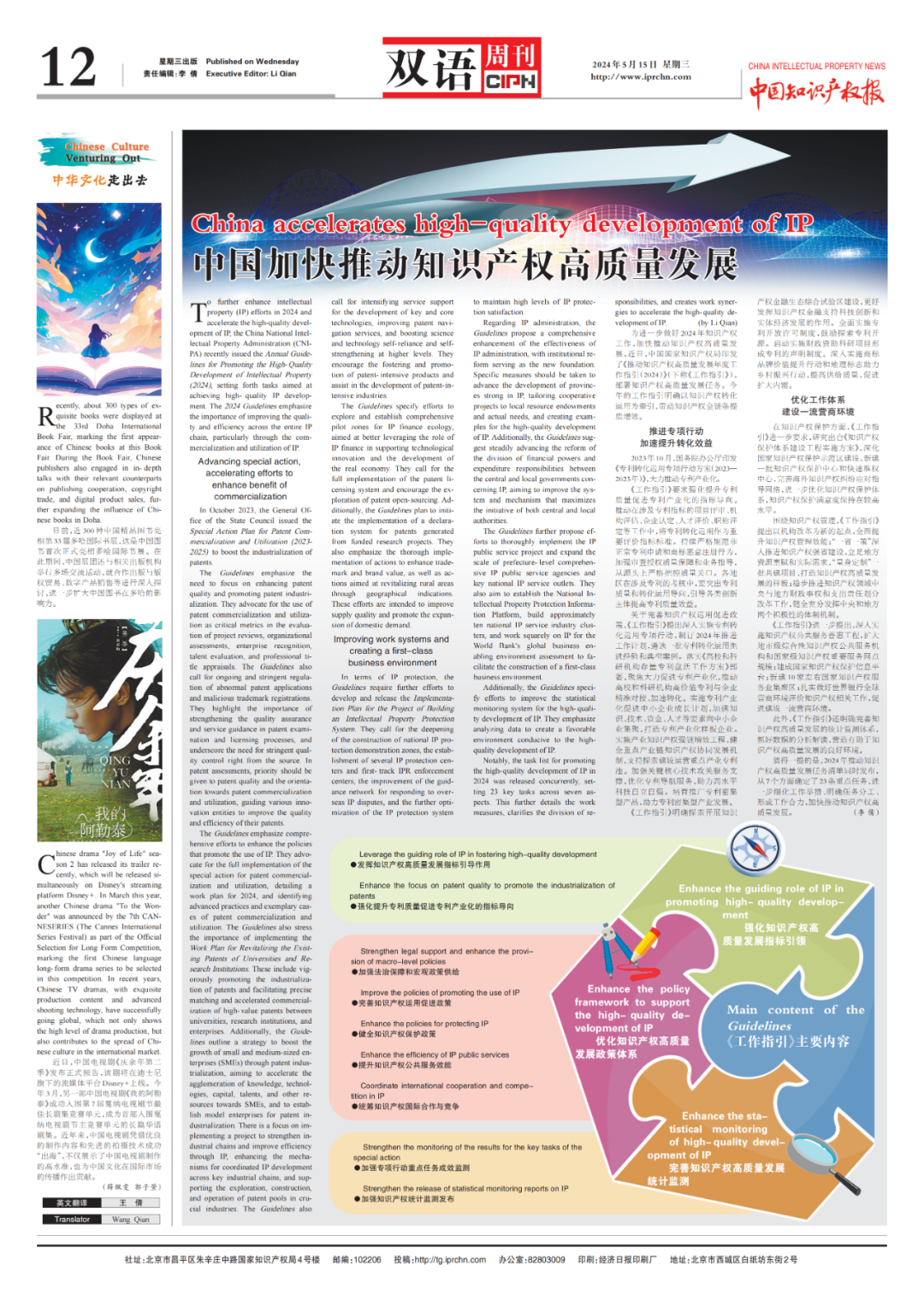微信扫一扫

中国加快推动知识产权高质量发展

China accelerates high-quality development of IP
To further enhance intellectual property (IP) efforts in 2024 and accelerate the high-quality development of IP, the China National Intellectual Property Administration (CNIPA) recently issued the Annual Guidelines for Promoting the High-Quality Development of Intellectual Property (2024), setting forth tasks aimed at achieving high-quality IP development. The 2024 Guidelines emphasize the importance of improving the quality and efficiency across the entire IP chain, particularly through the commercialization and utilization of IP.
Advancing special action, accelerating efforts to enhance benefit of commercialization
In October 2023, the General Office of the State Council issued the Special Action Plan for Patent Commercialization and Utilization (2023-2025) to boost the industrialization of patents.
The Guidelines emphasize the need to focus on enhancing patent quality and promoting patent industrialization. They advocate for the use of patent commercialization and utilization as critical metrics in the evaluation of project reviews, organizational assessments,enterprise recognition, talent evaluation, and professional title appraisals. The Guidelines also call for ongoing and stringent regulation of abnormal patent applications and malicious trademark registrations. They highlight the importance of strengthening the quality assurance and service guidance in patent examination and licensing processes, and underscore the need for stringent quality control right from the source. In patent assessments, priority should be given to patent quality and the orientation towards patent commercialization and utilization, guiding various innovation entities to improve the quality and efficiency of their patents.
The Guidelines emphasize comprehensive efforts to enhance the policies that promote the use of IP. They advocate for the full implementation of the special action for patent commercialization and utilization, detailing a work plan for 2024, and identifying advanced practices and exemplary cases of patent commercialization and utilization. The Guidelines also stress the importance of implementing the Work Plan for Revitalizing the Existing Patents of Universities and Research Institutions. These include vigorously promoting the industrialization of patents and facilitating precise matching and accelerated commercialization of high-value patents between universities, research institutions, and enterprises. Additionally, the Guidelines outline a strategy to boost the growth of small and medium-sized enterprises (SMEs) through patent industrialization, aiming to accelerate the agglomeration of knowledge, technologies, capital, talents, and other resources towards SMEs, and to establish model enterprises for patent industrialization.There is a focus on implementing a project to strengthen industrial chains and improve efficiency through IP, enhancing the mechanisms for coordinated IP development across key industrial chains, and supporting the exploration, construction, and operation of patent pools in crucial industries. The Guidelines also call for intensifying service support for the development of key and core technologies, improving patent navigation services, and boosting science and technology self-reliance and self-strengthening at higher levels. They encourage the fostering and promotion of patent-intensive products and assist in the development of patent-intensive industries.
The Guidelines specify efforts to explore and establish comprehensive pilot zones for IP finance ecology, aimed at better leveraging the role of IP finance in supporting technological innovation and the development of the real economy. They call for the full implementation of the patent licensing system and encourage the exploration of patent opensourcing. Additionally, the Guidelines plan to initiate the implementation of a declaration system for patents generated from funded research projects. They also emphasize the thorough implementation of actions to enhance trademark and brand value, as well as actions aimed at revitalizing rural areas through geographical indications. These efforts are intended to improve supply quality and promote the expansion of domestic demand.
Improving work systems and creating a first-class business environment
In terms of IP protection, the Guidelines require further efforts to develop and release the Implementation Plan for the Project of Building an Intellectual Property Protection System. They call for the deepening of the construction of national IP protection demonstration zones, the establishment of several IP protection centers and first-track IPR enforcement centers, the improvement of the guidance network for responding to overseas IP disputes, and the further optimization of the IP protection system to maintain high levels of IP protection satisfaction.
Regarding IP administration,the Guidelines propose a comprehensive enhancement of the effectiveness of IP administration, with institutional reform serving as the new foundation. Specific measures should be taken to advance the development of provinces strong in IP, tailoring cooperative projects to local resource endowments and actual needs, and creating examples for the high-quality development of IP. Additionally, the Guidelines suggest steadily advancing the reform of the division of financial powers and expenditure responsibilities between the central and local governments concerning IP, aiming to improve the system and mechanism that maximizes the initiative of both central and local authorities.
The Guidelines further propose efforts to thoroughly implement the IP public service project and expand the scale of prefecture-level comprehensive IP public service agencies and key national IP service outlets. They also aim to establish the National Intellectual Property Protection Information Platform, build approximately ten national IP service industry clusters, and work squarely on IP for the World Bank's global business enabling environment assessment to facilitate the construction of a first-class business environment.
Additionally, the Guidelines specify efforts to improve the statistical monitoring system for the high-quality development of IP. They emphasize analyzing data to create a favorable environment conducive to the high-quality development of IP.
Notably, the task list for promoting the high-quality development of IP in 2024 was released concurrently, setting 23 key tasks across seven aspects. This further details the work measures, clarifies the division of responsibilities, and creates work synergies to accelerate the high-quality development of IP. (by Li Qian)
为进一步做好2024年知识产权工作,加快推动知识产权高质量发展,近日,中国国家知识产权局印发了《推动知识产权高质量发展年度工作指引(2024)》(下称《工作指引》),部署知识产权高质量发展任务。今年的工作指引明确以知识产权转化运用为牵引,带动知识产权全链条提质增效。
推进专项行动 加速提升转化效益
2023年10月,国务院办公厅印发《专利转化运用专项行动方案(2023—2025年)》,大力推动专利产业化。
《工作指引》要求强化提升专利质量促进专利产业化的指标导向。推动在涉及专利指标的项目评审、机构评估、企业认定、人才评价、职称评定等工作中,将专利转化运用作为重要评价指标标准。持续严格规范非正常专利申请和商标恶意注册行为,加强审查授权质量保障和业务指导,从源头上严格把控质量关口。各地区在涉及专利的考核中,要突出专利质量和转化运用导向,引导各类创新主体提高专利质量效益。
关于完善知识产权运用促进政策,《工作指引》提出深入实施专利转化运用专项行动,制订2024年推进工作计划,遴选一批专利转化运用先进经验和典型案例。落实《高校和科研机构存量专利盘活工作方案》部署,聚焦大力促进专利产业化,推动高校和科研机构高价值专利与企业精准对接、加速转化。实施专利产业化促进中小企业成长计划,加速知识、技术、资金、人才等要素向中小企业集聚,打造专利产业化样板企业。实施产业知识产权强链增效工程,健全重点产业链知识产权协同发展机制,支持探索建设运营重点产业专利池。加强关键核心技术攻关服务支撑,优化专利导航服务,助力高水平科技自立自强。培育推广专利密集型产品,助力专利密集型产业发展。
《工作指引》明确探索开展知识产权金融生态综合试验区建设,更好发挥知识产权金融支持科技创新和实体经济发展的作用。全面实施专利开放许可制度,鼓励探索专利开源。启动实施财政资助科研项目形成专利的声明制度。深入实施商标品牌价值提升行动和地理标志助力乡村振兴行动,提高供给质量,促进扩大内需。
优化工作体系 建设一流营商环境
在知识产权保护方面,《工作指引》进一步要求,研究出台《知识产权保护体系建设工程实施方案》,深化国家知识产权保护示范区建设,新建一批知识产权保护中心和快速维权中心,完善海外知识产权纠纷应对指导网络,进一步优化知识产权保护体系,知识产权保护满意度保持在较高水平。
围绕知识产权管理,《工作指引》提出以机构改革为新的起点,全面提升知识产权管理效能;“一省一策”深入推进知识产权强省建设,立足地方资源禀赋和实际需求,“量身定制”一批共建项目,打造知识产权高质量发展的样板;稳步推进知识产权领域中央与地方财政事权和支出责任划分改革工作,健全充分发挥中央和地方两个积极性的体制机制。
《工作指引》进一步提出,深入实施知识产权公共服务普惠工程,扩大地市级综合性知识产权公共服务机构和国家级知识产权重要服务网点规模;建成国家知识产权保护信息平台;新建10家左右国家知识产权服务业集聚区;扎实做好世界银行全球营商环境评价知识产权相关工作,促进建设一流营商环境。
此外,《工作指引》还明确完善知识产权高质量发展的统计监测体系,抓好数据的分析解读,营造有助于知识产权高质量发展的良好环境。
值得一提的是,2024年推动知识产权高质量发展任务清单同时发布,从7个方面确定了23条重点任务,进一步细化工作举措、明确任务分工、形成工作合力,加快推动知识产权高质量发展。(李倩)


0条评论
推荐
投稿
我要投稿新帖
我要发帖-
诚“聘”精英!欢迎有志之士共谋未来#信息求助#
2024/08/17 21:00:43 甘肃丝路新世纪文化传播有限公司
甘肃丝路新世纪文化传播有限公司 -
最新!实现零的突破!#企业商讯#
2024/01/03 15:42:35 甘肃兴丰农林科技有限责任公司
甘肃兴丰农林科技有限责任公司 -
一颗土豆的成长“密码”——定西市安定区发展马铃薯产业发展观察#企业商讯#
2024/01/03 15:38:11 甘肃蓝天马铃薯产业发展有限公司
甘肃蓝天马铃薯产业发展有限公司 -
2023陇小南成绩单#企业商讯#
2024/01/03 15:32:31 甘肃陇小南生态农业发展有限公司
甘肃陇小南生态农业发展有限公司 -
众擎易举,重塑产业“品质美”——康县高质量发展观察(下)#企业商讯#
2024/01/03 15:29:10甘肃省康县兴源土特产商贸有限责任公司
 微信公众号
微信公众号



